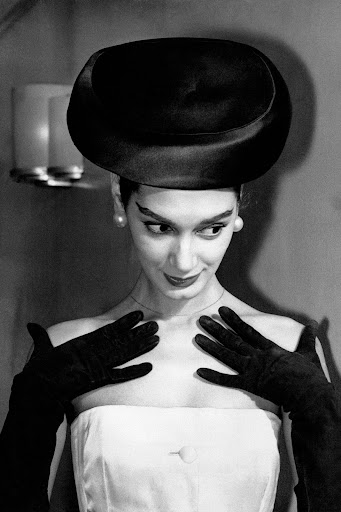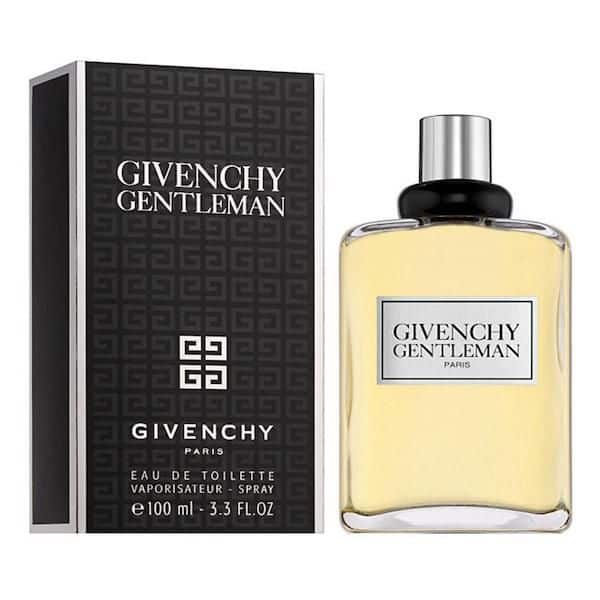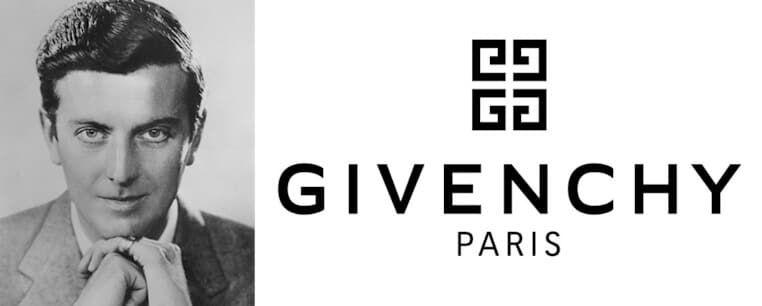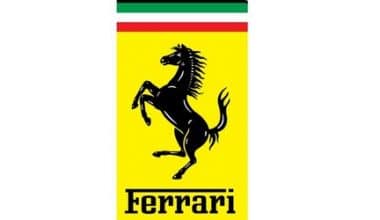Did you know that Givenchy designed Meghan Markle’s wedding gown for Prince Harry in 2018? The dress enraged the world’s media, social media, and a large number of viewers.
Givenchy is one of the most elegant fashion stories. Let’s look back at the history of legendary designer Givenchy. We’ll also look at the iconic designs, products, and evolution of the Givenchy Logo.
Givenchy’s Early History
Hubert De Givenchy’s Childhood and His Move to Paris
Paris, France is one of the world’s fashion capitals, and France has reigned as the center revolving around high fashion and luxury since the 16th century.
On February 27th, 1927, the French fashion designer Count Hubert James Marcel Taffin de Givenchy, also known as Hubert De Givenchy, was born in the small city of Beauvais in Northern France. Givenchy was three years old when his father died before he established a luxury empire. Lucien and Beatrice Taffin De Givenchy were his parents.
He also had a younger brother named Jean-Claude. When his father died in 1930, his interest in fashion grew as his mother and grandmother took over his late father’s role in Givenchy’s life. Their influence and impact inspired him to take the next big step in his life.
Hubert de Givenchy left Beauvais at the age of 17 to move to Paris, France, which is a one-hour and twenty-two-minute car ride today. Paris at the time was one of the best places for anyone starting out in fashion because there were so many opportunities for him to pursue.
Givenchy wanted to make all of the ideas he had in his head a reality, so he began his career as an apprentice for other fashion designers. Doing this in his late teens and early twenties not only allowed him to learn more about his new craft, but he also did it for free. All he wanted to do was learn more and more about fashion.
Givenchy worked for a number of designers, including Cristóbal Balenciaga, known as “The Master” of Haute Couture. He has also collaborated with Lucien Lelong, Robert Piguet, Jacques Fath, and others.
Hubert De Givenchy’s Beginnings in the Fashion Industry
Givenchy founded his own fashion house, the infamous Givenchy, in 1952 after doing a lot of apprenticeship work and gathering a lot of useful and practical information from everyone.
Separates was one of the very first collections he ever created. This was referred to as “elegant blouses with airy skirts.” Separates were also very simple and popular, laying the groundwork for the style that everyone knows today as Paris Chic. With its minimalistic and simple color palette, Paris is still known as the fashion industry’s epicenter to this day. Not only were women smitten with his collection, but it was an instant success.
The Bettina Blouse, named after a model he worked with named Bettina Graziani, is one of these popular pieces. During the 1940s and 1950s, she was one of Givenchy’s first muses.
Givenchy met the well-known Mr. Balenciaga a year after launching his own brand. He admired Balenciaga and saw him as a mentor and industry influencer, particularly for the brand he had launched the previous year. Givenchy was 25 years old at the time.
“The Sack Silhouette” was a piece he collaborated on with Balenciaga. During that time, this became another instant and popular hit. Women wore long cloaks and raised their legs with heels, giving them a mysterious appearance.
This created and pioneered the look of iconic 1960s women’s fashion. Things were starting to improve for the Givenchy brand by this point, as it was almost the 1960s.
As he progressed up the luxury ladder, he was introduced to the legendary actress Audrey Hepburn.
What caused Givenchy’s fame?
In order to reduce the prices of his designs, he founded his own firm in 1952 and maintained very minimal administrative costs. Givenchy’s inaugural collection, which featured impeccably crafted separates, high-fashion jackets, and beautiful ball gowns, received instantaneous international acclaim.
What does Givenchy stand for?
In 1970, Pierre Dinand designed the well-known Givenchy emblem, which is infused with the symbolism of the number 4. The brand’s guiding principles include arduous effort, rigid order, unwavering loyalty, and unquestionable sturdiness.
What impact did Givenchy have on fashion?
Putting together a wardrobe piece by piece. Givenchy also transformed the way women dress by popularizing women’s separates – interchangeable pieces of clothing that could be worn together – which is essentially how men and women shop for and wear clothing today.
How Audrey Hepburn Helped Hubert De Givenchy, Launch His Career
Coco Chanel popularized the Little Black Dress in 1926, and it became an instant statement piece for any woman who wore it. Despite the fact that she had the idea, it was Givenchy and Audrey Hepburn who made this one of the most iconic pieces in fashion history.
Hepburn was a British actress, philanthropist, and fashion icon best known for her role in the 1961 film Breakfast at Tiffany’s. The iconic dress is first seen in Hepburn in the opening scene of this film. Not only did this become one of the most famous dresses of all time, but it was sold for around $807,000 to help fund the construction of a school in Kolkata, India.
The Little Black Dress was one of Givenchy’s best and most well-known pieces because of how he transformed it from a simple dress into a look that every woman desired to wear.
But how did Givenchy go from being virtually unknown in the industry to now working with Audrey Hepburn? While on the set of Sabrina, a 1954 comedy-drama film, Hepburn quickly became close with the designer and requested that he create her set of costumes in 1953.
Sabrina was about a woman played by Audrey Hepburn who returns home after living in Paris and falls in love with David, but his brother wants him to marry someone wealthy so that the family legacy of wealth can continue.
Givenchy had planned to design work for Katharine Hepburn, but his ideas inspired Audrey to want him to work on her film instead. Because Hepburn was such a respected and iconic fashion figure during this time period, it was ideal for his reputation and elevated his name for others to know.
What is the oldest perfume by Givenchy?
Monsieur de Givenchy and l’Eau de Vetiver were introduced in 1957 and 1959, respectively, followed by the introduction of Givenchy III in 1970 with the phrase “Who knows why one is reminded of a specific woman and not another?
What is the Givenchy motto?
The inherent grace of Gentlemen Only maintains the image of a true gentleman. It is not archaic but becomes more daring with time.
Who dresses in Givenchy?
Kim Kardashian, Kendall & Kylie Jenner, Doja Cat, and others have been spotted wearing pieces from Matthew Williams’ Fall 21 collection prior to his debut runway presentation for the house. If you think back to October 2020, you may recall when Matthew Williams’s first Givenchy campaign appeared on Instagram.
Givenchy Brand History: The Transition
It was no surprise when LVMH purchased the brand in 1988, given its continued success. Hubert de Givenchy stepped down in 1995, after a career spanning more than four decades. He wanted to inspire a new generation of creatives to take over and bring his house into the new millennium.
He was briefly succeeded by John Galliano, Alexander McQueen, and Julien MacDonald. The brand didn’t get a new look until Riccardo Tisci took over in 2005. This shift would catch the public’s attention and elevate the brand to a new and coveted status.
Waight Keller and Tisci
Riccardo Tisci was well-known for his edgy yet romantic aesthetic, as well as his use of eclectic prints and out-of-the-ordinary color palettes. Tisci introduced many of the handbag silhouettes that made Givenchy famous over a 12-year period. The Antigona is the most recognizable. Its simple shape and structured silhouette quickly became the “it bag” of the year, and it quickly became nearly impossible to find.
Riccardo Tisci stepped down as creative director in 2017 to pursue other interests.
Givenchy made a bold move by hiring Clare Waight Keller as its first female creative director. This British-born designer was an obvious choice for the role, having worked at Ralph Lauren, Gucci, and Chloe.
This would prove to be fortuitous timing, as Clare Waight Keller was asked to design Meghan Markle’s wedding gown for her marriage to Prince Harry less than a year after her appointment. Though simple, the gown embodied the new creative director’s aesthetic while also exuding the look of bygone eras that Markle had requested.
Following the Royal Wedding, Meghan Markle and Rosamund Pike presented Waight Keller with the British Designer of the Year Womenswear Award.
Clare Waight Keller’s reign has grown more confident, and she has begun to experiment with the direction she wants to take Givenchy.
Recently, she has been sending more daring looks down the runway, capturing the simplicity she is known for while also incorporating the modern edgy twist Tisci established within the brand’s lifeblood.
As things stand, we’re excited to see where Waight Keller takes the luxury house, and we hope her time there thus far is an indication of what’s to come.
Givenchy Fashion Designers Throughout the Decades
Givenchy’s designers have always been in the spotlight, from Hubert de Givenchy and Audrey Hepburn to Clare Waight Keller and Meghan Markle. Vogue goes through the archives to look back at the star creatives who have shaped – and are shaping – the fashion industry.
A near-decade earlier, Hubert de Givenchy was in Paris realizing his own dream, far away from Fifth Avenue, where Holly Golightly stood reflected in Tiffany’s shopfront, breakfasting on croissants.
Seizing an opportunity to pioneer something new, the French aristocrat – and Elsa Schiaparelli prodigy – presented his first, frill-sleeved Givenchy show to a chorus of applause. The New York Times declared “A Star Is Born,” while Time magazine published a four-page feature titled “The New Name in Paris.”
“Paris’s Newest Name”

Givenchy’s first Spring/Summer 1952 collection introduced the world of couture to the concept of a separate wardrobe. In “Les Séparables,” fanciful shirts alternated with gabardine skirts. Bettina Graziani, Givenchy’s famous fit model and muse, inspired the Bettina Blouse, a white cotton shirt with flouncy flamenco sleeves.
His svelte capes, nifty houndstooth suits, and clean-line “sack” dresses were soon worn by Princess Grace of Monaco, Babe Paley, and Jacqueline Kennedy, but it was Hepburn who really put him on the map. She wore Givenchy on and off the set of films such as Sabrina (1954), Funny Face (1957), and, of course, Breakfast at Tiffany’s (1961).
When Givenchy retired in 1995, he was succeeded by the British enfant terrible John Galliano. His blooms were printed on second-skin skirt suits with tilted top hats to match, enthralling front rows with fashion theater-face veils, bolero jackets, and flower garlands. The following year, Galliano left Dior to be replaced by another Brit, Alexander McQueen. McQueen, who founded his own eponymous label in 1992, created a similar, but darker, spectacle for Givenchy.
In 2001, Welshman Julien Macdonald took the stage, bringing sequins and feather dresses to the label. He didn’t fit in, and while he did create black cocktail gowns for his final collection in 2004, the three-year fairy tale had come to an end.
Read Also: FASHION DESIGN BUSINESS: How to start a home-based fashion design business.
Riccardo Tisci, an Italian, took over in 2005 and reduced the fantastical fanfare of his predecessors. He presented a palate-cleansing collection of sheer white shirts and pussy-bow blouses for spring/summer 2006. Then he changed gears. His muses were Kim Kardashian and transgender model Lea T, and his dresses were either heavily embellished or barely there. Madonna wore him as her designer date to the Met Gala in 2016, but he left the following year, capping off a standout 12-year tenure that included head-to-toe leopard print, lashings of lace, septum piercing models, and fuchsia sequin face masks.
Clare Waight Keller, the first female artistic director at the house, took over from Chloé in May 2017. After an eight-year hiatus, she took over menswear and womenswear, as well as presenting her first-ever couture collection in January 2018. By May, she’d made another piece of history: Meghan Markle’s wedding gown to Prince Harry. The royal approval seal.
Famous Givenchy Designs
Givenchy forged a reputation for an eye-catching design with countless designs that garnered the respect of their contemporaries and an envious clientele as they continued to make a name for themselves in the fashion world.
Check out some of Givenchy’s most famous designs to get an idea of those iconic designs.
Baby Doll Gown (1958)
Givenchy created the Baby Doll Dress to liberate women, inspired by their close friend Balenciaga.
He stated, against convention, that he was inspired by a dream he had of a free woman who was no longer bound by layers and layers of fabric.
He described his new look as ultra-lightweight, emphasizing quick and fluid movement to empower the wearer.
Balloon Coat (1958)
Givenchy’s most well-known design and you can probably guess why!
Givenchy was embracing his dream of a liberated woman when he created the Baby Doll Dress the same year.
This wool coat was dubbed the “Balloon Coat.”
With its sloped shoulders and wide silhouette, this coat arrived at the turn of the 1960s and influenced the fashion of the era.
Audrey Hepburn’s Little Black Dress
The most famous LBD (little black dress) of all time?
The evening gown worn by Hepburn in the film earned the designer an Oscar nomination for Best Costume Design!
Their relationship changed both Hepburn’s and Givenchy’s lives.
Audrey Hepburn’s ‘Sabrina’ gown
After missing out on an Oscar nomination for wardrobe design, Givenchy nailed it for Audrey Hepburn’s hit film, Sabrina.
The gown she wore to the Larrabee family’s party was undoubtedly one of the highlights of the film’s costume design.
It was a stunning design that completely stole the show and displayed all of the hallmarks of haute couture.
Floral Hepburn Dress
The dress is so well-known that it has its own wiki page!
It’s unusual for a dress to achieve this level of celebrity. Jennifer Lopez, who wore an eye-catching gown to an event that inspired Google Images, is another example of a dress that accomplished this feat.
Hepburn wore this elegant white floral gown to the 1954 Academy Awards, and it is considered one of the most famous gowns of the twentieth century… Givenchy!
Introduction of Givenchy Gentleman and Givenchy Products

After the infamous Breakfast at Tiffany’s film, Hepburn continued to honor Givenchy by dressing her, creating a personal wardrobe for her, and designing nearly everything she wore on screen for the next four years. Working with Hepburn also gave his clothes the reputation of “elegance and wit,” which many people who knew Hepburn said her personality and appearance gave off.
She had even stated that Givenchy’s clothes were the only ones in which she felt truly herself. Aside from clothes, when he created a perfume in 1975, it was the first time an actress was ever going to be the face of a perfume advertisement. Since then, actresses, models, and others have continued to be the face of perfume brands.
Despite the fact that Hepburn was one of his most famous clients and friends, he also styled US First Lady Jacqueline Kennedy. When Kennedy visited the Palace of Versailles in 1961, she wore a Givenchy gown. Givenchy was also worn by Princess Grace of Monaco, the Duchess of Windsor, Babe Paley, and others.
Read Also: Women Lingerie Brands: 48 Best Women Lingerie Brands
While previously known only for producing women’s clothing, the first ready-to-wear collection for men, dubbed “Givenchy Gentlemen,” was created and launched in 1969. Givenchy wanted to incorporate the elegance that he associated with his brand and reputation into menswear. According to the line, “the Givenchy man was above all a gentleman.”
Since then, it has been so well received by the audience that he has had that he has been able to stay in the fashion industry as the designer of his own brand for two decades. Givenchy quickly became one of the top fashion houses in Paris, which is amazing to think about given that he came to Paris when he was 17 and now has this luxury empire.
Many A-listers and well-known celebrities were drawn to his classic reputation, which he had kept hidden for so long, and they all wanted his clothing. Givenchy began selling jewelry, shoes, ties, tableware, and upholstery, and even had the opportunity to design for the interiors of Hilton Hotels after noticing the impact he had on just clothes.
This expansion, which occurred between the late 1960s and the mid-1970s, enabled his brand to become much more diverse and branch out into industries other than clothing. In 1976, the brand expanded to Fifth Avenue in New York, with offices and showrooms opening.
Givenchy Retirement and LVMH Acquisition
However, after running this luxury brand for so long, it became tiresome, and Givenchy eventually sold it to the Luxury French conglomerate LVMH in Paris, France (Louis Vuitton Moet Hennessy). LVMH also owns two other fashion houses, Fendi and Christian Dior.
Givenchy was 68 years old when this happened in 1995, and he stayed with his brand for another seven years. He did this from 1979 to 1995, after which he was replaced by Ricardo Tisci.
In 2006, Tisci was named creative director of womenswear after it was claimed that several others had taken over the brand and were not staying true to the exact vision that Givenchy had built up on his brand for so long. Tisci accomplished this by incorporating many gothic, feminine, and fringe elements into the brand’s style and personality for 12 years in a row.
He even made history by being the first to feature a transgender woman in an advertising campaign, and he later became friends with Kanye West, who helped his designs gain popularity. Claire Keller took over after Tisci stepped down in 2017.
Givenchy – The Business
Givenchy was a businessman as well as a fashion designer. He recognized the importance of branding long before it became a marketing buzzword. He was one of the first designers to have his name officially licensed.
Givenchy was also the first fashion designer to have his brand appear on non-clothing items. This entailed broadening the product line beyond fashion to include china, silverware, and hotel draperies.
Givenchy’s Fashion Influence Throughout History And Today
Givenchy, like many other fashion designs and industry figures, left an indelible mark on the world of fashion. Despite not having invented the Little Black Dress, he was able to transform it into something striking, subtle, and sexy due to the way it made a woman’s figure. How did this survive as a fashion statement in today’s world?
Many argue that the way Givenchy incorporated feminine, edgy, and simple looks is still used in some of his collections today. Personally, I believe that some of the collections created by Keller, the current creative director, do not accurately represent the idea and vision that Givenchy would have wanted his brand to convey.
Personally, I believe Givenchy has had a significant influence on how men dress today in clean, classic, and luxurious looks. This idea of having such a sleek look for men was not widely displayed until the 1960s when fashion was much more prevalent, and he eventually introduced his menswear line as well.
With so many celebrities and iconic fashion figures in history wanting his pieces, the fact that Audrey Hepburn herself wanted Givenchy to design her Sabrina costumes after only knowing him for a short time says a lot about him. Hepburn took a chance on him, and he was able to stick with it and leave a lasting impression, propelling him to the top of the fashion world.
Personally, I believe Givenchy has had a significant influence on how men dress today in clean, classic, and luxurious looks. This idea of having such a sleek look for men was not widely displayed until the 1960s when fashion was much more prevalent, and he eventually introduced his menswear line as well.
Read Also: HOW MUCH DO FASHION DESIGNERS MAKE: Updated Salary 2022
With so many celebrities and iconic fashion figures in history wanting his pieces, the fact that Audrey Hepburn herself wanted Givenchy to design her Sabrina costumes after only knowing him for a short time says a lot about him. Hepburn took a chance on him, and he was able to stick with it and leave a lasting impression, propelling him to the top of the fashion world.
Givenchy was also able to make Hepburn the face of his perfume, which had never been done before at the time, and is something that many perfume brands and companies do today as well. It’s almost unheard of for a high-end, well-known, or luxury brand not to use an industry icon to promote their product, and all thanks to Givenchy.
Givenchy Logo

Givenchy Logo: History and Significance
Hubert de Givenchy and Javani Robert Durfy founded the fashion house in 1952. Paul Barnes created the current logo in 2003.
There is an older logo that looks very similar to the current one, with a few minor differences. The top end of the “G” in the previous version is cut so that it is not aligned with the lower half of the letter (as it is on the current emblem). The “C” is also different: in the old logo, the ends are cut diagonally, whereas, in the new one, the ends are cut so that a single vertical line can pass through them.
Givenchy Logo: The Emblem
Givenchy’s logo is straightforward and functional. The font is sans serif with traditional proportions. All of the letters are capitalized, and there is plenty of space between them. As a result, the wordmark is perfectly legible in any size, large or small.
The wordmark is sometimes used alone, but it is also frequently combined with the Givenchy symbol. The symbol is made up of four letters “G” that form a distinct pattern that resembles Celtic jewelry.
The lettering “Givenchy” (with or without the quadruple “G” symbol) is sometimes combined with the word “Paris,” which is given in smaller letters below.
Givenchy Perfume Logo
In addition to the main Givenchy logo, Givenchy uses a fragrance-specific logo. It is based on the primary wordmark, which takes center stage in the design. The word “Parfums” (French for “perfumes”) can be seen above. It is considerably smaller than the word “Givenchy.”
Conclusion
During the 1950s, women’s fashion was largely divided, and it didn’t begin to emerge until almost a couple of years later, in the 1960s. Givenchy was still heavily influenced by everything in his environment.
Women were wearing skirts and tops, so he created his first collection, “separates,” to give women a sexy, sleek, and elongated but elegant look while doing anything. Givenchy’s only goal in life was to make women more beautiful than they already were, and he was able to accomplish this before his death in March 2018.
Hubert de Givenchy died peacefully in Neuilly-sur-Seine, France, at the age of 91. He received a Lifetime Achievement Award from the Council of Fashion Designers of America in 1996, and much of his work is on display for the public at exhibitions such as the Fashion Institute of Technology’s museum.
Taking the huge leap at such a young age to pursue a passion for which he had no idea would lead to a long-term career was one of the most remarkable and courageous things Givenchy could’ve ever done. There would never have been such a large impact on the world of fashion if he had not done this.
Related Articles
- Expensive Purse Brands: List Of Most Expensive Purse Brands
- DESIGNER BAG BRANDS: Exhaustive List of the Top Best and Affordable Brands
- Best Socks Brands: 30 Cool Socks Brands in 2022
- Luxury Bag Brands: Top 2022 Luxury Handbag Brands List (Updated)






